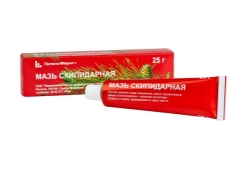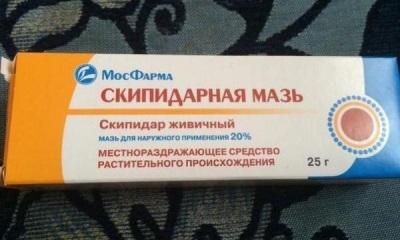Use of Turpentine Cough Ointment for Children
When a child suffers from coughing, adults try to help the crumbs in any way, resorting not only to taking syrups or mixtures, but also to different procedures. One of these procedures, recommended when coughing a child, is rubbing with ointments. Turpentine ointment is often used for it.
Turpentine is called an ointment, the main ingredient of which is gum turpentine. It is a natural plant material extracted from the resin of coniferous trees. Its active ingredient is represented by turpentine oil.
This ointment is produced in glass jars, as well as in aluminum tubes of 25, 30 or 50 g. In addition to turpentine, this 20% ointment contains water and petroleum jelly.
Operating principle
Due to the presence of turpentine, the ointment has an anesthetic, antiseptic, warming and anti-inflammatory effect. It affects the receptors of the skin, has a distracting effect, dilates blood vessels and causes blood flow to the site of application. When coughing this ointment warms the bronchi, relieves inflammation and pain. This drug also showed its high efficacy in pains in muscles and joints, neuritis and neuralgia.
Contraindications and adverse reactions
Ointment containing turpentine should not be used in children with:
- Hypersensitivity to its components.
- Liver disease.
- Kidney disease.
- Dermatitis.
- Bronchial asthma.
- Increased body temperature.
- Damage to the skin at the site of application.
The most frequent side effect from the use of turpentine ointment is irritation of the skin at the site of application. The development of allergic reactions is also possible.
The child begins to complain of itching and burning, the skin may redden, become covered with a rash or become edematous. More rare adverse reactions to rubbing with ointment with turpentine are choking and cramps. Also, in some babies, after such rubbing, blood pressure may fall.
Instructions for use
- Turpentine ointment is used only externally, applying to the desired areas of the skin with a thin layer.
- When coughing, the back, chest and feet are most often treated with this drug.
- The ointment is applied in the evening before bedtime.
- When rubbing the chest should avoid the heart area, and do not put the drug on the nipples.
- After applying the ointment on the child wear linen from natural fabric. If you rub your feet, wear wool socks on top.
- The duration of use of the ointment should be no more than 7 days.
If after applying the child's health worsened, immediately wash the ointment and show the baby to the doctor.
Reviews
Attitudes to rubbing with turpentine when coughing like doctors and parents is very different. Someone is satisfied with this drug and uses it often enough, but there are parents who, like some doctors, categorically do not accept rubbing with turpentine.
Parents who use turpentine ointment for rubbing, most often follow the advice of a pediatrician or older relatives. They note that such procedures can cure a cold in the first days of the disease. Literally 2-3 rubbing - and a light cough passes.
Many use turpentine ointment not only for procedures in a child, but also for their own treatment.Among the disadvantages of using turpentine ointment, parents note that the procedure often causes skin irritation or an allergic reaction.
Usage tips
Before using turpentine ointment when coughing, it is important to show the child to the doctor. Typically, the use of this drug in the age of 2 years is limited only to the treatment of the feet, and rubbing the chest and back can be only two years old and older. At the same time, doctors do not recommend the use of turpentine in children under 7 years of age without urgent need.
Since turpentine is allergic, before the first use it is advised to do a test on a small area of skin. If a little redness appears, you can mix 1: 1 turpentine ointment with any baby cream. Such a diluted version would be the best choice for the first use of turpentine ointment when coughing.
With a strong cough, it is effective to use a mixture of turpentine ointment and honey or a mixture of such ointment and badger oil. To enhance the effect of the use of turpentine ointment before rubbing it is necessary to give the child hot tea with raspberries or currants.
You will learn more about turpentine by watching the following video.
Opinion Komarovsky
A popular pediatrician classifies rubbing with turpentine ointment to a group of distracting procedures, which he considers ineffective. According to Komarovsky, such procedures only help calm the parents, but do not affect the speed of recovery of the child.
When coughing, a famous doctor advises to pay attention to adequate ventilation of the room in which the child is staying, sufficient amount of drinking and walking in the fresh air.
Komarovsky is confident that such available methods are much more efficient than rubbing or applications. expectorant means.














